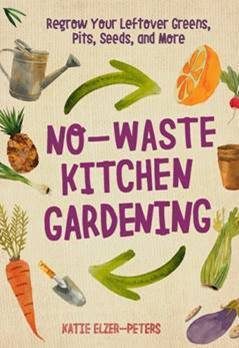When in the kitchen whipping up salads, soups, and stews, you typically pile up random scraps from freshly sliced veggies and fruits. Possibly, within that slurry of unwanted produce pieces, you have pits and seeds that could be the foundations for fresh new plants. Instead of tossing them, put them to work.
Katie Elzer-Peters, an author with bachelor’s and master’s degrees in horticulture, describes exactly how to “regrow your leftover greens, stalks, seeds, and more” in her book, “No-Waste Kitchen Gardening.”


Author Katie Elzer-Peters / Photo by Kirsten Boehmer
Easy, Fun, and Free
We spoke with Elzer-Peters about her experience with kitchen gardening, and summarized our discussion in a Q&A format. She says using food discards to sprout fresh new plants — including edible plants — is easy. It’s also fun. And it’s free.
Earth911: What are some of the easiest kitchen scraps to recycle as edible plants?
Elzer-Peters: Celery. Head lettuce. Green onions. You can regrow lettuce, onions, and celery in water on your kitchen countertop. It’s so easy. You need water and the right part of the plant. Identifying the right part of the plant is a key element in the book.
Earth911: What are some of the other kitchen scraps discussed in “No-Waste Kitchen Gardening”?
Elzer-Peters: Sweet potatoes. Avocado pits. Pineapple tops. Turnips. Radishes. Leeks. Garlic. Carrots. And various others.

Green onions are among the array of vegetables featured in the book “No-Waste Kitchen Gardening.” Photo by Kirsten Boehmer
Seeds & Popcorn
Earth911: What are some of the most interesting or unusual items you’ve sprouted?
Elzer-Peters: Items from your spice rack. Sesame seeds, caraway seeds, coriander seeds, mustard seeds, and other seeds sprout into edible microgreens. Unpopped popcorn kernels yield microgreens with a sweet flavor.
Earth911: What do you want readers to take away from “No Waste Kitchen Gardening”?
Elzer-Peters: I want them to be excited about trying some of these things. And to be able to look at the foods that they are buying for cooking recipes and think about what they might be able to regrow from them and squeeze a little more out of what they bought. What I tried to do is make the science accessible and interesting. If you read this book, you’ll know a lot more about the plants you’re eating. You’ll have a better understanding of where your food comes from.
Earth911: What are some of your personal kitchen scrap preferences?
Elzer-Peters: I want to try to regrow of more of our lettuce, celery, and green onions because those are easy and I use them a lot.
Earth911: Why should readers think about recycling kitchen scraps?
Elzer-Peters: It’s usually easy. It potentially saves money, and it reduces food waste. Every time you throw [the stem from a head of lettuce] away, you’re potentially throwing away six to 10 more lettuce leaves. Also, it’s fun. Watching these plants change from what you brought home in a bag from the grocery story is very interesting.
Earth 911: Any other words of wisdom?
Elzer-Peters: I think its really simple. Once you know what to do, it’s not a lot of work. A lot of this type of re-growing is kind of an experiment. Sometimes the plant roots and sometimes it doesn’t. If something doesn’t sprout, simply throw it way — or toss in the compost pile — and start again.
“No-Waste Kitchen Gardening” by Katie Elzer-Peters
Regrow Green Onions
Excerpt From “No-Waste Kitchen Gardening”
You will need a cup or bowl, a sharp knife, and some pebbles.
- Prepare the onions for rooting by cutting off the green tops and leaving about an inch of the stem (mostly white) attached to the roots at the very bottom.
- Fill the bottom of the cup or bowl with ½ to ¾ inch of clean pebbles.
- Fill a cup or bowl with water so that the pebbles are covered with ½ inch of water.
- Place the bottoms of the onions in the pebbles, making sure that the pieces are half submerged.
- Set the cup or bowl in an area of bright, indirect light. The more light, the longer your regrowing onions will last.
- Change the water every couple of days.
Harvest and keep growing! Snip off the young green leaves for use on top of soups, to add flavor to sandwiches, and for stirring into salads. Keep your green onion harvest growing longer by planting the rooted cuttings in potting soil or into the garden outside. Green onions grow best during cool weather, so plant them outside during the spring or fall.
Feature image: sprouting avocado plant (Adobe Stock). This article was originally published on March 26, 2019.
The post Q&A With Author: ‘No-Waste Kitchen Gardening’ appeared first on Earth 911.








